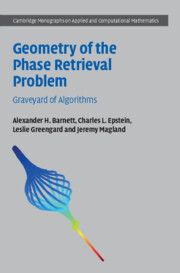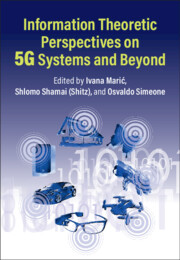Refine listing
Actions for selected content:
9096 results in Communications, Signal Processing and Information Theory
4 - Multihop Wireless Backhaul for 5G
- from Part I - Architecture
-
- Book:
- Information Theoretic Perspectives on 5G Systems and Beyond
- Published online:
- 19 April 2022
- Print publication:
- 05 May 2022, pp 131-165
-
- Chapter
- Export citation
19 - Cognitive Cooperation and State Management: An Information Theoretic Perspective
- from Part III - Protocols
-
- Book:
- Information Theoretic Perspectives on 5G Systems and Beyond
- Published online:
- 19 April 2022
- Print publication:
- 05 May 2022, pp 683-749
-
- Chapter
- Export citation
Part III - Protocols
-
- Book:
- Information Theoretic Perspectives on 5G Systems and Beyond
- Published online:
- 19 April 2022
- Print publication:
- 05 May 2022, pp 509-510
-
- Chapter
- Export citation
Index
-
- Book:
- Information Theoretic Perspectives on 5G Systems and Beyond
- Published online:
- 19 April 2022
- Print publication:
- 05 May 2022, pp 750-756
-
- Chapter
- Export citation
4 - Uniqueness and the Nonnegativity Constraint
- from Part I - Theoretical Foundations
-
- Book:
- Geometry of the Phase Retrieval Problem
- Published online:
- 21 April 2022
- Print publication:
- 05 May 2022, pp 85-102
-
- Chapter
- Export citation
13 - Suggestions for Improvements
- from Part III - Further Properties of Hybrid Iterative Algorithms and Suggestions for Improvement
-
- Book:
- Geometry of the Phase Retrieval Problem
- Published online:
- 21 April 2022
- Print publication:
- 05 May 2022, pp 249-291
-
- Chapter
- Export citation
14 - Information Theoretic Aspects of 5G Protocols
- from Part III - Protocols
-
- Book:
- Information Theoretic Perspectives on 5G Systems and Beyond
- Published online:
- 19 April 2022
- Print publication:
- 05 May 2022, pp 511-532
-
- Chapter
- Export citation
Part II - Analysis of Algorithms for Phase Retrieval
-
- Book:
- Geometry of the Phase Retrieval Problem
- Published online:
- 21 April 2022
- Print publication:
- 05 May 2022, pp 107-108
-
- Chapter
- Export citation
15 - Interference Management in Wireless Networks: An Information Theoretic Perspective
- from Part III - Protocols
-
- Book:
- Information Theoretic Perspectives on 5G Systems and Beyond
- Published online:
- 19 April 2022
- Print publication:
- 05 May 2022, pp 533-580
-
- Chapter
- Export citation
2 - The Geometry Near an Intersection
- from Part I - Theoretical Foundations
-
- Book:
- Geometry of the Phase Retrieval Problem
- Published online:
- 21 April 2022
- Print publication:
- 05 May 2022, pp 39-64
-
- Chapter
- Export citation
9 - Phase Retrieval with the Nonnegativity Constraint
- from Part II - Analysis of Algorithms for Phase Retrieval
-
- Book:
- Geometry of the Phase Retrieval Problem
- Published online:
- 21 April 2022
- Print publication:
- 05 May 2022, pp 191-204
-
- Chapter
- Export citation
6 - Cloud and Fog Radio Access Networks
- from Part I - Architecture
-
- Book:
- Information Theoretic Perspectives on 5G Systems and Beyond
- Published online:
- 19 April 2022
- Print publication:
- 05 May 2022, pp 193-225
-
- Chapter
- Export citation
2 - Information Theory for Cellular Wireless Networks
-
- Book:
- Information Theoretic Perspectives on 5G Systems and Beyond
- Published online:
- 19 April 2022
- Print publication:
- 05 May 2022, pp 10-92
-
- Chapter
- Export citation
6 - Introduction to Part II
- from Part II - Analysis of Algorithms for Phase Retrieval
-
- Book:
- Geometry of the Phase Retrieval Problem
- Published online:
- 21 April 2022
- Print publication:
- 05 May 2022, pp 109-114
-
- Chapter
- Export citation
7 - Communication with Energy Harvesting and Remotely Powered Radios
- from Part I - Architecture
-
- Book:
- Information Theoretic Perspectives on 5G Systems and Beyond
- Published online:
- 19 April 2022
- Print publication:
- 05 May 2022, pp 226-264
-
- Chapter
- Export citation

Geometry of the Phase Retrieval Problem
- Graveyard of Algorithms
-
- Published online:
- 21 April 2022
- Print publication:
- 05 May 2022

Information Theoretic Perspectives on 5G Systems and Beyond
-
- Published online:
- 19 April 2022
- Print publication:
- 05 May 2022
Bibliography
-
- Book:
- Machine Learning
- Published online:
- 27 May 2022
- Print publication:
- 31 March 2022, pp 327-334
-
- Chapter
- Export citation
3 - Basic Parametric Models and a Statistical Perspective on Learning
-
- Book:
- Machine Learning
- Published online:
- 27 May 2022
- Print publication:
- 31 March 2022, pp 37-62
-
- Chapter
- Export citation
1 - Introduction
-
- Book:
- Machine Learning
- Published online:
- 27 May 2022
- Print publication:
- 31 March 2022, pp 1-12
-
- Chapter
- Export citation
